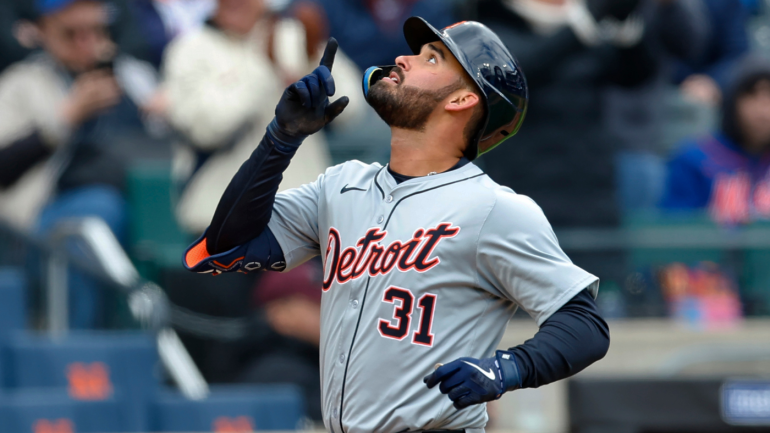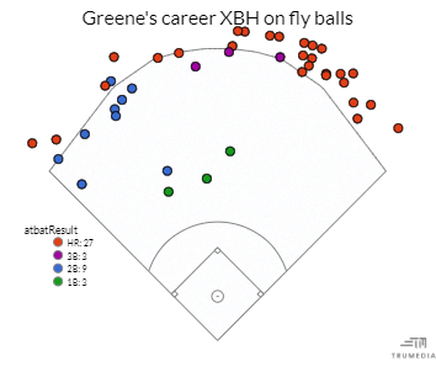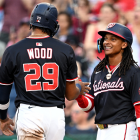
Tigers' Riley Greene could be MLB's most improved hitter thanks to better approach and power appetite
Greene has opened his third season in the majors better than ever

Here's a question for you, dear reader: can you guess who ranks fourth among American League position players in Baseball Reference's version of Wins Above Replacement? If you've been paying attention to such matters (and hey, it's early May), you probably know that Bobby Witt Jr., Marcus Semien, and Gunnar Henderson sit atop the leaderboard. Fourth, though, belongs to Detroit Tigers outfielder Riley Greene, who has already contributed an estimated 2.2 WAR in his first 37 games.
While all the usual caveats about WAR and small sample sizes apply, the Tigers have to feel good about how the 23-year-old Greene has performed this season. He'll enter Friday batting .254/.373/.515, good for a would-be career-best 151 OPS+. He's only three home runs away from setting a new single-season personal best, too, having hitherto launched nine. Mind you, this is someone who appeared in more than 90 games in each of the last two seasons, so this isn't just a function of increased playing time.
Rather, Greene's apparent breakout can be attributed to a few underlying changes in his game and his circumstances. Below, we've highlighted three factors that have allowed Greene to serve as one of the majors' best performers through the first month-plus of the season.
1st pitch of the game? Riley Greene was ready for it. 💪 pic.twitter.com/muziMPmIsp
— MLB (@MLB) May 6, 2024
1. Leaning into strength
Generally, if a batter wants to hit for more power they should prioritize pulling the ball in the air. To wit, nearly 70% of all home runs hit at the big-league level this year have been launched to the batter's pull side. (All of them caught air, obviously.) How does a batter lean into that? Often by altering their point of contact, so they're meeting the ball further out in front. Other times, batters have to change their swing planes, adding loft so that they're more likely to lift the ball.
Rather than getting too far in the weeds with that stuff, we'll just note that whatever Greene is doing differently this season has worked. Take a look at this handy dandy table:
| Season | Pulled FB% | Opposite field FB% |
|---|---|---|
2024 | 26.9% | 23.1% |
2023 | 23.3% | 50% |
2022 | 8.9% | 60.7% |
As you can see, this could be the first time in Greene's big-league career that a greater chunk of his fly balls are going to right field than to left field. In turn, those fly balls stand a better chance of clearing the fence. You don't have to take our word for it, either. Check out Greene's career spray on extra-base hits that were classified as fly balls:

Greene is strong enough to hit doubles and some occasional home runs to left field. Right and right-center, though, is where he's most likely to clear the fence. His home-run barrage this season is the result of him recognizing that reality and tweaking his game to better align with it.
2. Improved approach
Even with Greene gearing up to hit for more power by pulling the ball in the air, he's displayed a quantifiably better approach at the plate this season. This may seem self-evident given that his walk rate has improved from 8.4% to 15.5%, but he's been more picky about what he's swinging at. His chase rate has declined from 26.5% to 20.6%, and his overall swing rate has dipped about a corresponding amount. Swinging less doesn't always equal a better approach. It does here, however.
Wasting no time! 💣 pic.twitter.com/0rJHlCUGxC
— Detroit Tigers (@tigers) May 4, 2024
Baseball Prospectus author Rob Orr created a metric we've referenced before called SEAGER. Essentially, it attempts to gauge if a batter is making wise swing decisions -- that is, swinging at pitches they can damage and laying off those they cannot. Greene has improved in both respects, according to Orr's metrics. He's offering more at hittable pitches, all the while upping his in-zone contact rate, and -- as mentioned above -- expanding his zone less frequently.
Combine those trends with Greene's newfound slugging capacity, and you have a batter who has greatly enhanced their offensive upside.
3. Better defensive fit
Greene's overall game has also benefited from a defensive change. Whereas he primarily played center field during his first two seasons in the majors, this season he's almost exclusively played left field, with Parker Meadows taking most of the playing time in center. The early returns suggest that Greene is a better fit in a corner, as evidenced in the table below by his defensive metrics. (Again, we feel obligated to note that public-facing defensive metrics are notoriously unreliable, so take this with several grains of salt.)
| Season | OAA | DRS | DRP |
|---|---|---|---|
2024 | 2 | 7 | 1.5 |
2023 | 0 | -6 | 0 |
2022 | 0 | 2 | 2.2 |
History is full of decent center fielders moving to a corner and blossoming defensively. Oftentimes, that's because the corner outfield spots don't require as much range. Sometimes, though, players read the ball off the bat better when they're stationed at an angle rather than head-on.
Whatever the case here, Greene has always graded well from a jump perspective. His routes, conversely, tended to be substandard per ball-tracking data. He's already made a number of low-probability snags this year, supporting the idea he's a better fit in left than he was in center.
Add those gains to Greene's offensive progress, and he stands a great chance of becoming the Tigers' first homegrown position player to make an All-Star Game since Alex Avila in 2011.




















